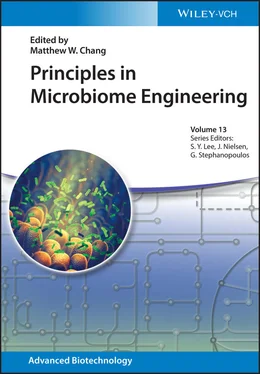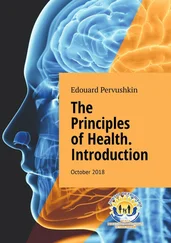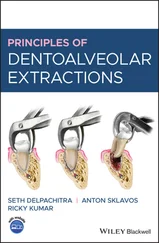Principles in Microbiome Engineering
Здесь есть возможность читать онлайн «Principles in Microbiome Engineering» — ознакомительный отрывок электронной книги совершенно бесплатно, а после прочтения отрывка купить полную версию. В некоторых случаях можно слушать аудио, скачать через торрент в формате fb2 и присутствует краткое содержание. Жанр: unrecognised, на английском языке. Описание произведения, (предисловие) а так же отзывы посетителей доступны на портале библиотеки ЛибКат.
- Название:Principles in Microbiome Engineering
- Автор:
- Жанр:
- Год:неизвестен
- ISBN:нет данных
- Рейтинг книги:5 / 5. Голосов: 1
-
Избранное:Добавить в избранное
- Отзывы:
-
Ваша оценка:
- 100
- 1
- 2
- 3
- 4
- 5
Principles in Microbiome Engineering: краткое содержание, описание и аннотация
Предлагаем к чтению аннотацию, описание, краткое содержание или предисловие (зависит от того, что написал сам автор книги «Principles in Microbiome Engineering»). Если вы не нашли необходимую информацию о книге — напишите в комментариях, мы постараемся отыскать её.
Provides an overview of the techniques and applications insight into the complex composition and interactions of microbiomes Principles in Microbiome Engineering
Principles in Microbiome Engineering
Principles in Microbiome Engineering — читать онлайн ознакомительный отрывок
Ниже представлен текст книги, разбитый по страницам. Система сохранения места последней прочитанной страницы, позволяет с удобством читать онлайн бесплатно книгу «Principles in Microbiome Engineering», без необходимости каждый раз заново искать на чём Вы остановились. Поставьте закладку, и сможете в любой момент перейти на страницу, на которой закончили чтение.
Интервал:
Закладка:
Table of Contents
1 Cover
2 Title Page Principles in Microbiome Engineering Edited by Matthew W. Chang
3 Copyright Volume Editor Prof. Dr. Matthew W. Chang National University of Singapore Department of Biochemistry 28 Medical Drive 117456 Singapore Singapore Series Editors Prof. Dr. Sang Y. Lee KAIST 373‐1, Guseong‐Dong 291 Daehak‐ro, Yuseong‐gu 34141 Daejeon South Korea Prof. Dr. Jens Nielsen Chalmers University Department of Chemical and Biological Engineering Kemivägen 10 412 96 Göteborg Sweden Prof. Dr. Gregory Stephanopoulos Massachusetts Institute of Technology Department of Chemical Engineering Massachusetts Ave 77 Cambridge, MA 02139 United States Cover Image: © shutterstock All books published by WILEY‐VCH are carefully produced. Nevertheless, authors, editors, and publisher do not warrant the information contained in these books, including this book, to be free of errors. Readers are advised to keep in mind that statements, data, illustrations, procedural details or other items may inadvertently be inaccurate. Library of Congress Card No.: applied for British Library Cataloguing‐in‐Publication Data A catalogue record for this book is available from the British Library. Bibliographic information published by the Deutsche Nationalbibliothek The Deutsche Nationalbibliothek lists this publication in the Deutsche Nationalbibliografie; detailed bibliographic data are available on the Internet at < http://dnb.d-nb.de >. © 2022 WILEY‐VCH GmbH, Boschstrasse 12, 69469 Weinheim, Germany. All rights reserved (including those of translation into other languages). No part of this book may be reproduced in any form – by photoprinting, microfilm, or any other means – nor transmitted or translated into a machine language without written permission from the publishers. Registered names, trademarks, etc. used in this book, even when not specifically marked as such, are not to be considered unprotected by law. Print ISBN: 978‐3‐527‐34725‐4 ePDF ISBN: 978‐3‐527‐82547‐9 ePub ISBN: 978‐3‐527‐82548‐6 oBook ISBN: 978‐3‐527‐82546‐2 Cover Design Adam-Design, Weinheim, Germany
4 Preface
5 1 Diet‐Based Microbiome Modulation: You are What You Eat 1.1 Introduction 1.2 Dietary Lifestyle Variation Affecting Host Microbiome 1.3 Dietary Modulation of Microbiome for Disease Treatment 1.4 Challenges and Opportunities 1.5 Concluding Remarks Acknowledgments References Notes
6 2 Microbiome Engineering for Metabolic Disorders 2.1 Introduction 2.2 Microbiome Engineering for Diabetes and Obesity 2.3 Microbiome Engineering to Modulate Gut–Liver Axis 2.4 Microbiome Engineering for Cardiovascular Diseases 2.5 Microbiome Engineering to Modulate Gut–Brain Axis 2.6 Clinical Translation of Live Biotherapeutic Products 2.7 Conclusion and Future Directions References
7 3 Repurposing Microbes for Therapeutic Applications in Humans 3.1 Introduction 3.2 A Brief Overview of Microbiota and Human Health 3.3 Systems Biology Approach to Analyze the Gut Microbiota Functions 3.4 Engineering Microbiome to Treat Diseases 3.5 Perspectives and Conclusion References
8 4 Modulating Residence Time and Biogeography of Engineered Probiotics 4.1 Introduction 4.2 Adhesion Mechanisms 4.3 Adhesion Modulation 4.4 Functional Encapsulations and Biofilms that Modify Gastrointestinal Dynamics of Probiotics 4.5 Metabolic Engineering to Modulate Gut Adaptation 4.6 Conclusions References Note
9 5 Microbiome Engineering for Next‐Generation Precision Agriculture 5.1 Background 5.2 Systems Approach to Microbiome Engineering 5.3 Synthetic Biology for Genome and Genetic Engineering of Phytobiomes 5.4 Conclusion and Future Perspectives Acknowledgments References
10 6 Biological Sensors for Microbiome Diagnostics 6.1 Introduction 6.2 Diagnosing the Microbiome 6.3 Types of Biosensors 6.4 Testing and Utilizing Engineered Biosensors 6.5 Conclusions/Summary Acknowledgments References
11 7 Principles, Tools, and Applications of Synthetic Consortia Toward Microbiome Engineering 7.1 Introduction 7.2 Advantages of Labor Division via Synthetic Microbial Consortia 7.3 Tools for Engineering Synthetic Consortia 7.4 Engineering Syntrophy 7.5 Engineering Population Control 7.6 Synthetic Microbial Consortia and the Human Microbiome 7.7 Conclusions and Future Perspectives References
12 8 Fecal Microbiota Transplantation for Microbiome Modulation: A Clinical View 8.1 Introduction 8.2 Fecal Microbiota Transplantation (FMT) 8.3 Clinical Application of Fecal Microbiota Therapy 8.4 FMT – Novel Indications 8.5 Conclusion References
13 9 Maternal Microbiota as a Therapeutic Target 9.1 Introduction 9.2 Human Maternal Microbiota 9.3 Maternal Microbiota and Health 9.4 Human Milk Microbiota and Infant Health 9.5 Drug Treatment, Unhealthy Conditions, and Microbiome 9.6 Probiotic and Prebiotic Therapies as Modulators of Microbiome References
14 10 Transcription Factor‐Based Biosensors and Their Application in Microbiome Engineering Summary 10.1 Design: TF‐Based Biosensors 10.2 Build: TF‐Based Biosensors 10.3 Test: TF‐Based Biosensors Application in Microbiome 10.4 Learn: Strategies for TF‐Based Biosensor Improvement 10.5 Conclusions Acknowledgments References Note
15 Index
16 Wiley End User License Agreement
List of Tables
1 Chapter 1 Table 1.1 Effects of dietary protein on host‐gut microbiota. Table 1.2 Effects of natural and artificial sugar on gut microbiota. Table 1.3 Effect of non‐digestible carbohydrates on gut microbiota. Table 1.4 Effect of dietary fat on gut microbiota. Table 1.5 Infrastructures supporting microbiome research.
2 Chapter 2 Table 2.1 Examples of gut microbiome and metabolites associated with psychi...Table 2.2 Preclinical studies for different diseases with the probiotics us...Table 2.3 Clinical studies for different diseases with the probiotics used ...
3 Chapter 3Table 3.1 Microbial diagnostics for the detection of disease states.
4 Chapter 5Table 5.1 Summary of the popular tools for analyzing ‐omics data.
5 Chapter 6Table 6.1 Recent examples of engineered biosensing probiotics.
6 Chapter 8Table 8.1 A list of FMT donor‐screening studies.
7 Chapter 9Table 9.1 Gut microbiota during pregnancy.Table 9.2 Factors that influence the breast milk microbiota.
8 Chapter 10Table 10.1 Transcription factor (TF)‐based biosensors for microbiome applic...
List of Illustrations
1 Chapter 1 Figure 1.1 The average adult human microbiota composition of five body sites... Figure 1.2 The socioeconomic impact on dietary habits.(a) The schematic of ... Figure 1.3 The composition of the gut microbiome in people at different age ... Figure 1.4 Dietary perturbation of the microbiome to improve human health.T... Figure 1.5 Protocol of FMT.Stool from healthy donors are screened and teste...
2 Chapter 2 Figure 2.1 (a) Number of publications over the years with keywords shown in ... Figure 2.2 Engineering approaches to modulate microbiome functions and vario... Figure 2.3 Integrated metabolism of key metabolites by the host and gut micr...Figure 2.4 Pathway for the translation of live biotherapeutic products (LBPs...
3 Chapter 3Figure 3.1 Impacts of gut microbiota on human metabolism and physiology. (a)...Figure 3.2 Notable characteristics essential for efficient colonization of B ...Figure 3.3 Use of microbes for diagnostic and therapeutic purposes. (a) E. c ...Figure 3.4 Systems biology approaches to characterize the gut microbiome. Me...
4 Chapter 4Figure 4.1 Highlighted strategies to modulate probiotic delivery site and re...
5 Chapter 5Figure 5.1 Schematic illustrating the “Design–Build–Test–Learn” approach use...
Читать дальшеИнтервал:
Закладка:
Похожие книги на «Principles in Microbiome Engineering»
Представляем Вашему вниманию похожие книги на «Principles in Microbiome Engineering» списком для выбора. Мы отобрали схожую по названию и смыслу литературу в надежде предоставить читателям больше вариантов отыскать новые, интересные, ещё непрочитанные произведения.
Обсуждение, отзывы о книге «Principles in Microbiome Engineering» и просто собственные мнения читателей. Оставьте ваши комментарии, напишите, что Вы думаете о произведении, его смысле или главных героях. Укажите что конкретно понравилось, а что нет, и почему Вы так считаете.












